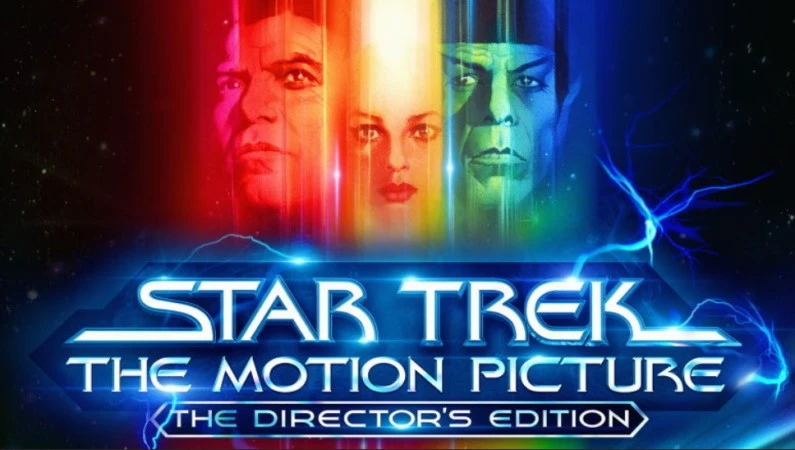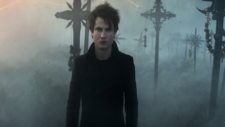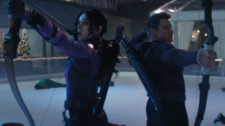This month is the 43rd anniversary of Star Trek: The Motion Picture, which premiered on December 7, 1979. The movie was helmed by veteran director Robert Wise. The screenplay is credited to Harold Livingston, based on a story by Alan Dean Foster, although there were a number of other writers involved in the protracted task of bringing the movie from concept to completion. Over four decades later TMP remains a highly contentious subject among Star Trek fans.
My own personal experience with TMP was that I had only seen it all the way through, from beginning to end, a few times, and always on television. Hey, I was only three years old in 1979, so I was too young to catch it in the theater! In general I found it to be fairly underwhelming.
A few months ago Michele and I finally got our first wide screen television. Over the years some people have argued that TMP works much better on a big movie theater screen than on TV. Since a widescreen television is closer to a “big screen” than I’ve ever had before, I figure it was time to watch TMP in a manner as close to the original experience as possible. In early September I streamed the 4K Ultra HD (high definition) version of Star Trek: The Motion Picture – The Director’s Edition on Paramount Plus. And, honestly, it WAS a brand-new experience for me.
I realize that part of that is also due to the fact that in the late 1970s TMP was an incredibly rushed production, and what ended up on movie screens was little more than a rough cut. Twenty years later Robert Wise was finally given the opportunity to conduct some badly-needed additional work on TMP, resulting in The Director’s Edition that came out in 2001. The 4K Ultra HD version further improves on the picture quality & special effects.

After I finished watching this version of TMP, I had to admit the movie was pretty darn cool. It definitely looked much better on a wide-screen television. This was the first time I really was able to take in the incredible visuals. Also, at 46 years old, I certainly had much more of an understanding and appreciation of the cerebral, philosophical nature of the story. So, yes, certainly the most enjoyable viewing of TMP that I’ve ever had. Here are some of my thoughts about the movie:
First off, whenever I watch the opening credits of TMP my mind automatically starts thinking “Why are they using the theme music from Star Trek: The Next Generation?” Yeah, yeah, I know… TMP came out eight years before TNG made its debut. But TNG was essential viewing for me when I was a teenager, so that theme song is very familiar to me, and I probably never watched TMP from beginning to end until after TNG finished up its run in 1994. Consequently whenever Jerry Goldsmith’s opening theme plays I just automatically think of Picard and Riker and Data and all that.
I understand that for a lot of fans in 1979 what Goldsmith produced was just too different from the already-iconic Star Trek theme composed by Alexander Courage. But the Goldsmith piece is well done, so it makes perfect sense that it was later repurposed for TNG, something that I feel helped that show establish its own distinct identity in a way that wouldn’t have been possible if the Courage theme had been used.

Moving on to the movie itself, that opening scene with the redesigned Klingons (sporting their bumpy foreheads & armor for the very first time) is actually a pretty good way to set up the central crisis. The Klingons were the closest the original Star Trek series had to a “big bad.” So it’s an effective method of establishing just how incredibly powerful & dangerous V’Ger is by having a trio of badass-looking Klingon battle cruisers get effortlessly obliterated in the very first scene. I guess this is an early example of what would later be known as The Worf Effect, which of course takes its name from TNG’s own resident Klingon warrior.
For years I had wondered why Wise had included that extended sequence of James T. Kirk in a shuttlecraft slowly, lovingly admiring the redesigned Starship Enterprise. This was but the first of several sequences that I feel works much better on a larger, wider screen. It really does look impressive.
It’s also important to remember the context. In 1979 Star Trek had been off the air for ten years. Yes, it had been in endless syndication during that time, but this was the first live-action Star Trek in a decade. It was also the very first time the series was ever seen on the big screen. So it makes sense for Wise to really take as much time as he did to spotlight the Enterprise, which literally had never been seen like this before.
I do have to give William Shatner credit for really selling this scene, for showing Kirk’s understated yet nevertheless palpable joy at once again seeing his beloved Enterprise. Shatner would have been looking at a blank wall or something when that scene was filmed, with only Wise’s direction and his own imagination to go on, but he totally sells it. Shatner has an admittedly well-deserved reputation for being a large ham. But given the right material and a strong director he could turn in powerful, subtle performances, and he did good work in this movie.

I still do think the new Starfleet uniforms and interiors of the Enterprise are “Meh.” I don’t know what it was about the 1970s that resulted in such a preponderance of subdued beiges and greys in fashion & decor, but all of it makes the future seen in TMP very bland. The red uniforms that were introduced three years later in Star Trek II: The Wrath of Khan were a vast improvement.
It feels like new characters Will Decker and Ilia, played by Steven Collins and Persis Khambatta, should be more important, that their ultimate fates should be genuinely dramatic. But neither character is given enough material to really develop within the confines of movie’s roughly two hour runtime. I believe Ilia does get slightly more emphasis in The Director’s Edition — apparently a scene showcasing her empathic abilities was absent from the theatrical cut — but it’s only a slight improvement.
I think both characters had potential, but there just was not enough time in an already-packed movie to develop either of them sufficiently. So I can understand why series creator Gene Roddenberry essentially recycled them in TNG, with young, ambitious Will Decker becoming young, ambitious Will Riker and the empathic Deltan Ilia becoming the empathic half-Betazoid Deanna Troi. A weekly television series certainly afforded more of an opportunity to explore the characters and their complex relationship.

For me the standout element of TMP was Leonard Nimoy’s superb performance as Spock. I feel TMP is essential viewing for Star Trek fans because it is a crucial moment in the character arc of the half-Vulcan, half-human Spock. In the original series Spock was a figure torn between two worlds as he struggled to reconcile his rigidly logical Vulcan heritage & training with his very emotional human heritage.
The first time we see Spock in TMP he has returned to his home planet where he attempts a Vulcan ritual to at last purge himself completely of emotion, only to meet with failure. He then telepathically senses the approach of V’Ger, a being possessing “thought patterns of exactingly perfect order.” And so Spock rejoins the Enterprise because he believes this mysterious entity may contain the solution he has sought for so long.
When Spock subsequently mind melds with V’Ger he confirms the entity is indeed a being of pure logic… yet for all its phenomenal power & knowledge V’Ger’s existence is incredibly barren. Spock discovers that logic alone has not been able to provide V’ger with true meaning & purpose:
“V’ger has knowledge that spans this universe. And in all this order, all this magnificence, V’ger feels no awe…no delight… no beauty… no meaning… no hope…”
For the first time Spock realized just how empty the path of pure logic can be. This really carries over through the remaining appearances in the Star Trek franchise, where he is finally at peace with himself, having at last found a balance between his logical Vulcan and emotional human sides.

DeForest Kelly isn’t given nearly as much to do in his role of Dr. Leonard “Bones” McCoy. For the most part Bones is his typical curmudgeonly self. But occasionally there are glimpses of the humanistic warmth that lies beneath his irascibility.
When Kirk drags McCoy back into service early on, there’s a great exchange between the two that really establishes the later character:
Kirk: Well, for a man who swore he’d never return to the Starfleet…
McCoy: Just a moment, Captain, sir. I’ll explain what happened. Your revered Admiral Nogura invoked a little-known, seldom-used “reserve activation clause.” In simpler language, Captain, they DRAFTED me!
Kirk: They didn’t!
McCoy: This was your idea. This was your idea, wasn’t it?
Kirk: Bones, there’s a… thing… out there.
McCoy: Why is any object we don’t understand always called “a thing”?
I’ve always appreciated that last line, as it gets right to the heart of what I feel is one of the central tenets of Star Trek: exploring the unknown, seeking to understand that which seems different & frightening.
I also appreciated how in TMP we see how McCoy is the one person who won’t put up with Kirk’s bullshit. Bones readily perceives that Kirk, tired of riding a desk at Starfleet Command for the past two and a half years, exploits the V’Ger crisis to take back command of the Enterprise, in the process trampling over Decker, who was supposed to be the new captain, and the doctor has absolutely no qualms on calling Kirk out on his behavior.

As for the rest of the Enterprise crew… uh, yeah, they really don’t get all that much to do, unfortunately. But I’m sure that it in 1979 it was awesome to see all of them back together. And I appreciated that Christine Chapel and Janice Rand, now promoted to Doctor and Transporter Chief respectively, were among the characters who returned. One way in which the original series is a product of its time is that there were very few prominent regular female characters. So it was good to have Majel Barrett and Grace Lee Whitney appear here, however briefly.
I certainly can’t write about TMP without discussing V’Ger itself… or Voyager 6, as it is revealed to be in the climax of the movie. V’Ger does look absolutely spectacular, and I suppose I can forgive those looooong tracking shots the immense living machine. And in the 4K Ultra HD version we finally get to see exactly what V’Ger looks like.
It’s certainly a legitimate criticism to point out the similarities between V’Ger in TMP and Nomad from the original series episode “The Changeling” broadcast in 1967; they’re both space probes from Earth that merged with incredibly advanced alien technology, becoming immensely powerful beings that threatened the galaxy while seeking out their “Creator.” But whereas Nomad was merely a dangerous foe for Kirk to defeat, V’Ger is ultimately the equivalent of a lost soul, one that is finally helped onto the next step of its evolution by the Enterprise crew.
As I said at the outset, as an older and (hopefully) more mature viewer I now appreciate that the crisis in TMP is ultimately resolved peacefully, and everyone involved emerged with a better understanding of themselves and each other.

So, looking at Star Trek: The Motion Picture, it’s a good yet flawed movie. It had a lot of potential & ambition, but regrettably it sometimes falls short. It sacrifices some of the warmer, human aspects of the show to focus on Big Ideas. At times the movie’s pacing is a bit too languid. I like TMP, but I also agree that the next entry, The Wrath of Khan, is much stronger and ultimately helped to save the Star Trek franchise. I do feel that if you put the two movies side by side it demonstrates the diversity of the series, in that there are a lot of different types of stories you can tell. As far as I’m concerned, that’s one of Star Trek’s greatest strengths.




I was 16 when I saw ST:TMP for the first time. I remember anxiously waiting for it to start and my jaw dropping open when you saw the Enterprise for the first time. It definitely wasn’t a perfect movie, but after waiting for so long for new Star Trek adventures, it was still amazing to see it on the big screen. And it opened the way for much better films like Wrath of Khan and all the additional series.